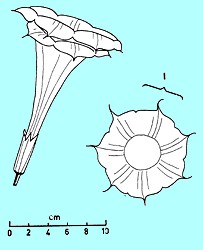
Synonymy
*Datura metel L., Sp. Pl. 1: 179 (1753)
T: `Habitat in Asia, Africa';
Lectotype : Herb. Clifford: 55, Datura 2 [gamma] (BM-000557992).
See the Linnaean Plant Name Typification Project pages for further details and for an image of the specimen.
See also Hadkins et al. (1997). Typification of Linnaean Datura names. Bot. J. Linnean Soc. 125: 295-308.
Description
Annual herb, glabrous or sparsely pubescent with non-glandular hairs.
Mature leaves ovate to broadly ovate and angular, up to 16 cm long and 15 cm wide, slightly sinuate to coarsely serrate.
Calyx 4–7 cm long, 5 (occasionally up to 9)–lobed, the base persistent in fruit; lobes 8–15 mm long. Corolla usually double or triple, the inner one 14–20 cm long, deep purple outside, pale lavender to white inside; limb 5 (occasionally to 9)–lobed, the lobes ending in slender point 10–25 mm long. Stamens not exserted; anthers 8–12 mm long. Style 10–14 cm long; stigma 2–4 cm below anthers.
Capsule globose or nearly so, 3–4 cm diam., deflexed, tuberculate; tubercles 100–200, conical, all about equal in length, 2–5 mm long. Persistent base of calyx to 3 mm long. Seeds 4–5 mm long, yellow.
Distribution and ecology
Believed to have originated in Asia; widely cultivated in the tropics and as an indoor plant in temperate regions.
In Purdie et al. (1981) Fl. Austral. 29: 194, noted as an uncommon garden escape in Qld, N.S.W., S.A., W.A., and N.T. Records in herbaria and state censuses presently only indicate this to be the case in Qld, NSW and WA. (rmb Feb. 2006).
Notes
The name D. metel was commonly misapplied to D. inoxia Miller and D. wrightii Regel in early Australian literature.
A recent analysis of the origins of Datura metel (Luna-Cavazos et al. 2008) indicates that it is likely to have evolved by human selection from D. inoxia.
M. Luna-Cavazos, R. Bye & M. Jiao (2008) The origin of Datura metel (Solanaceae): genetic and phylogenetic evidence. Genetic Resources and Crop Evolution (Published online first). doi: 10.1007/s10722-008-9363-5
Selected specimens
W.A.: Melville, A.S. George 4377 (PERTH). N.T.: cult. Alice Springs, 8 June 1958, G. Chippendale (NT). S.A.: cult. Blackwood, S.A., from seed 320 km from Alice Springs, N.T., A. Ashby 87 (AD). Qld: Thursday Island, 4 Oct. 1971, M. Williams (BRI). N.S.W.: cult. Brewarrina, May 1926, J.R. Burns (NSW).
Derivation of epithet
Metel is apparently the Arabic name for the fruits of this plant.
Images and information on web
An image of the fruits of D. metel can be seen at http://florabase.calm.wa.gov.au/browse/photo/6963
The Datura and Brugmansia Society has images of various corolla forms of this species on its site: see www.abads.net/datura/metel/
Further information can be found on the Weeds in Australia site.
D. metel as a weed in the Pacific is treated on the Pacific Island Ecosystems at Risk (PIER) site.
Further information about the toxic properties of this plant can be found with a search in the FDA Poisonous Plant Database
A comprehensive fact sheet on D. metel in
Plant status (if any)
General information about Datura species as declared plants in
All species of Datura are declared in Western Australia, Tasmania and Northern Territory while D. ferox, D. inoxia and D. stramonium are included in Victorian legislation.
Information on the occurrence and declaration of Datura in




